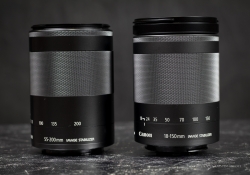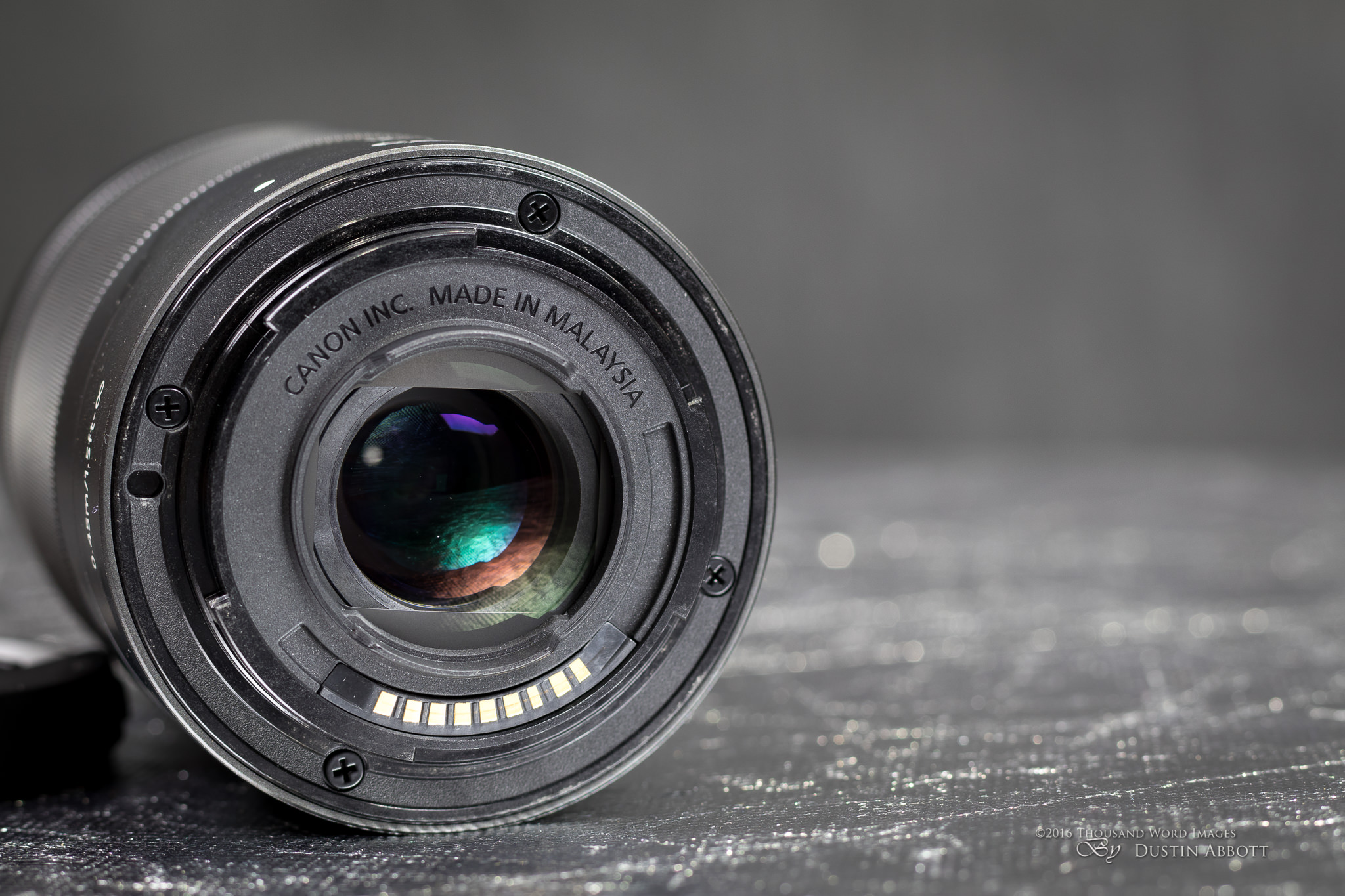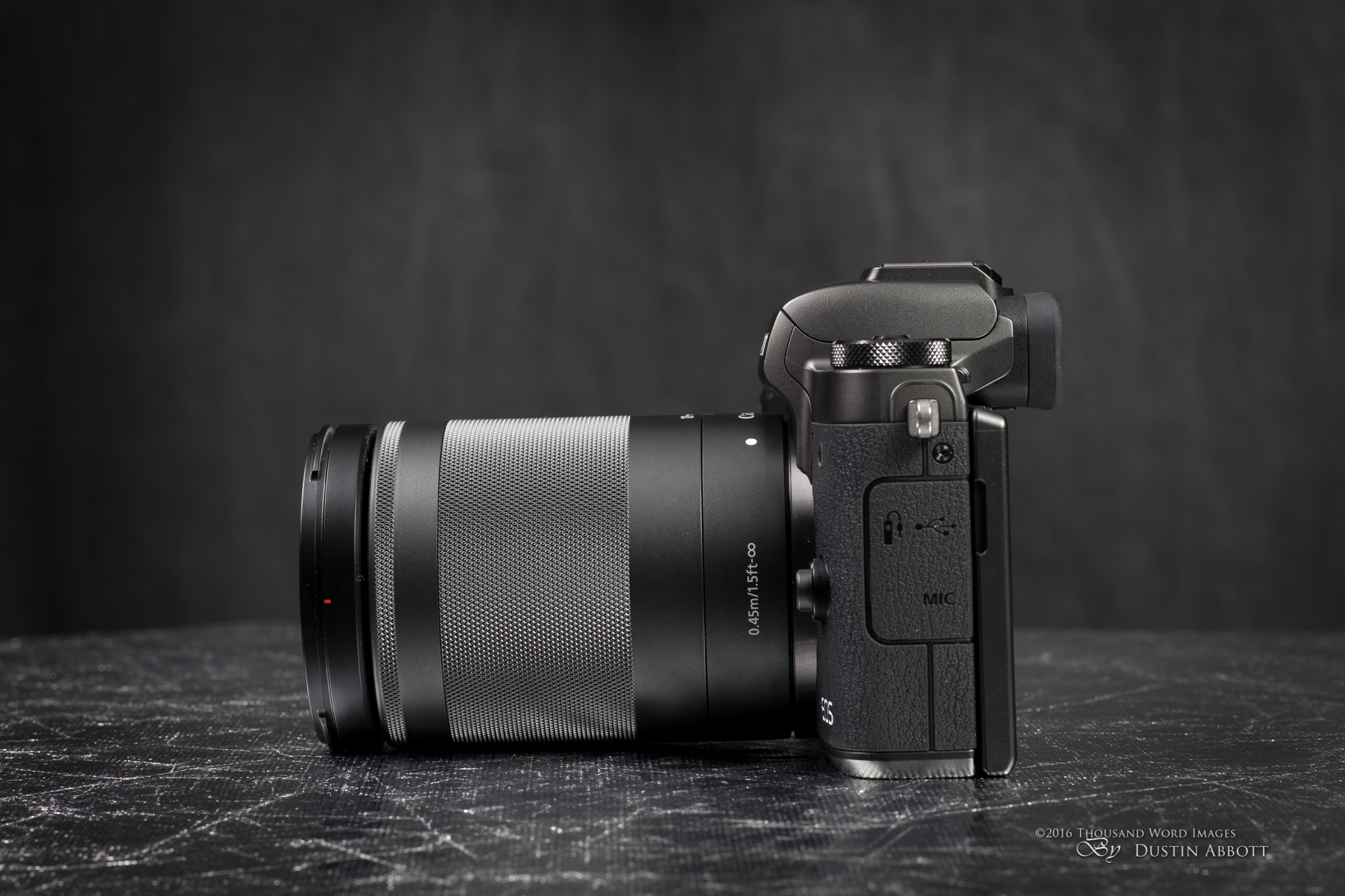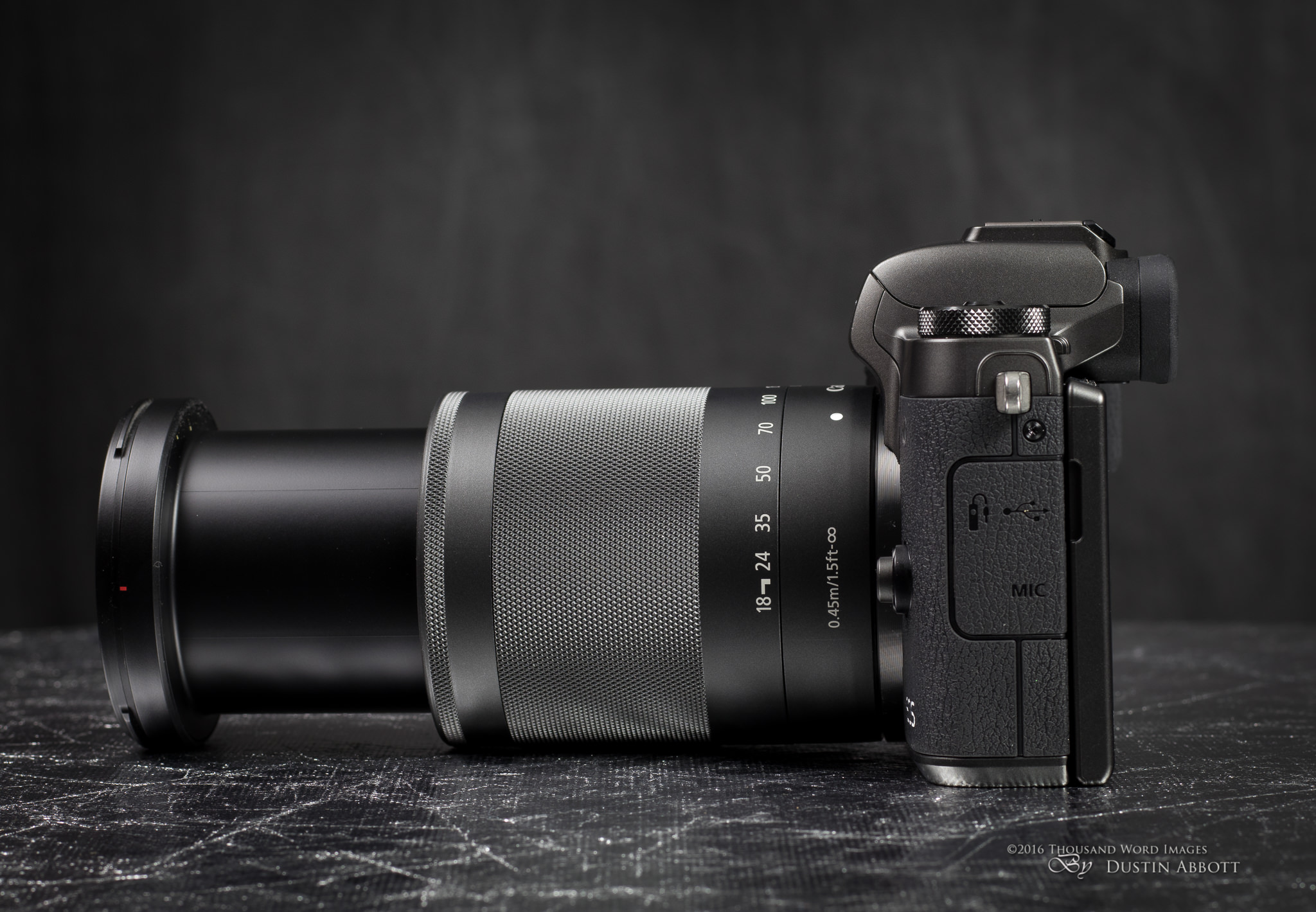Canon EF-M 18-150mm f/3.5-6.3 IS STM Review
Dustin Abbott
January 23rd, 2017
New EF-M mount lenses have been fairly few and fair between, but 2016 saw two very solid lenses released: the EF-M 28mm f/3.5 Macro IS STM lens (my review here) and this lens, the Canon EF-M 18-150mm f/3.5-6.3 IS STM. The 18-150 STM is both similar and different to past EF-M zooms. It is similar in the sense that it is another variable aperture zoom lens (Canon has favored these “slow” lenses for the system due to their small size and weight), but different in that it provides more of a genuine all-in-one solution than what the system has previously seen…at least from Canon. Tamron has had a very competent 18-200mm option for the system for several years (I reviewed that lens here), though it is worth noting that it is about 50% heavier than this lens and is currently not compatible with the EOS M5 until a lens firmware update is released (Tamron had a similar issue when the M3 was released but was able to fix it via firmware). Update: the firmware update was released on January 17th. Contact your local Tamron distributor to receive the firmware update. But Canon’s own all-in-one solution is here, and the 18-150 STM is a very compelling lens on a lot of levels.
Prefer to watch your reviews? I’ve got you covered. Click the video below to see my video review of the EF-M 18-150mm STM.
I used the 18-150 STM extensively while on a extended trip to Arizona as well as here in Canada. I used it in a wide variety of settings and got a good sense of its capabilities. Read on to find out more!
Build and Design
In this video I break down the overall build, design, and features of the lens. It will give you a good sense of the lens itself.
The 18-150 STM essentially borrows the body from the 55-200 STM. They are physically near identical. They are both 2.4” (60.9mm) in diameter, and one is 3.4” (86.36mm) while the 55-200 is 3.41” (86.5mm) long. That fraction of a mm is imperceptible. What is perceptual is the difference in weight. While both are light, the 18-150 STM feels a little denser at 10.6 oz (301g) vs. 9.17oz (260g). This is due to the 18-150 STM having a slightly denser optical formula. Both have 17 elements, but they are in 13 groups rather than 11 in the 18-150 STM. Both have seven rounded aperture blades.
Though the barrels are the same in diameter the 18-150 STM has a slightly larger 55mm (vs 52mm) front filter thread. I’ve ranted in the past how that almost all of the lenses I’ve tested for the M system (both Canon and third party) have different filter sizes. There is no attempt at standardizing…which is a little annoying.
The 55-200 STM is optically impressive, but the one thing I’ve lamented is its somewhat uninspiring minimum focus distance (3.28 feet or 1 meter) and the resulting pedestrian 0.21x maximum magnification. It just often feels like you should be able to get closer than you can. The 18-150 STM solves that problem by cutting the minimum focus distance in half (1.5 feet or .45m) and thus getting a much more satisfying 0.31x maximum magnification despite having a shorter maximum focal length. This near 1/3rd life size figure adds a LOT of versatility to the lens, and it seems to perform quite well near minimum focus. Here’s a look comparing the magnification of the two lenses:
The zoom ring is big, texturized, and easy to find. The zoom action is very, very smooth and nicely damped. The focus ring is much smaller, and is somewhat of an afterthought with STM lenses anyway. The focus ring does not physically connect to any of the moving parts in the lens (STM lenses take input from the focus ring and use the focus motor to move the internal parts). As a result the focus ring feels smooth but, well, disconnected…because it is.
I will note that the build quality of Canon’s EF-M lenses has declined since the release of the 18-55mm STM, 22mm STM, and 11-22mm STM lenses. They feel a bit more plasticky now, and have plastic lens mounts rather than the metal ones employed on the earlier lenses. I used to be able to say that the EF-M lenses were better made than their EF-S counterparts, but that’s not really the case anymore. For those keeping score, this lens says, “Made in Malaysia” stamped into the mount.
I do like Canon’s EF-M lens design. It is clean and modern, and I’m partial to the texture that is used on the focus and zoom rings. It is worth noting that this lens comes in two different finishes: Graphite (like my review copy) and Silver.
The lens barrel extends an additional [almost] 1 3/4″ or 4cm when zoomed to the 150mm position.
Autofocus and Image Stabilization (STM + IS)
The 18-150 STM employs Canon’s STM or Stepping Motor technology. This was originally designed more for smooth focus changes for video servo AF, but has become the de facto focus system for all of Canon’s EF-M mount lenses to date. STM technology continues to excel more at smoothness than speed, though focus speed is pretty decent here. Focus changes on the wide end are near instantaneous (depth of field is much greater, thus focus changes are smaller), and while the speed slows down a bit at 150mm, in good light it is still extremely quick. In dim light it needs a little more time, while the wide end remains extremely fast. I used the lens extensively while at the new OdySea Aquarium in Scottsdale, Arizona. The dim light, shooting through glass, and trying to track movement did expose a few limitations, but overall the lens (and the EOS M5 body I was using it on) mostly allowed me to get what I wanted. There were a few moments that I wished for a DSLR and a different lens in my hand, but they were fortunately rare. Here’s a few of the photos I was able to get with this combination while there.
My focus accuracy on the trip was really quite good, and I feel like this is a strong implementation of Canon’s STM technology in terms of focus speed. Focus changes in video mode are smooth and essentially silent. In fact, don’t plan on hearing this lens focus at all. It is, for all practical purposes, completely silent in operation. Even with the Image Stabilizer running and shooting video I can only hear the faintest click periodically with my ear pressed right up against it. Otherwise, under normal stills shooting, all you hear is the beep that announces focus acquisition.
The lens also employs Canon’s IS (Image Stabilization) system, and this lens is designed to compliment the new digital 5-axis IBIS (In Body Image Stabilization) in the EOS M5, but only during video recording. I do admire how Canon has created a complimentary system rather than a competing one (as sometimes exists in the Sony ecosystem). You don’t have to choose one or the other. When capturing stills, however, the IBIS is not in operation, and so just the lens’ IS will be activated. The image stabilization works quite well, and I had no problem handholding 1/10th second shots at 150mm, though my keeper rate tailed off quickly with slower shutter speeds than this. The image below is captured at 1/10th second shutter speed and 150mm.
The IS in the lens is reported to automatically sense panning motion and turn off stabilization for the X-axis to allow smooth panning motion.
Canon 18-150mm Image Quality
Superzoom lenses always require a certain degree of compromise to make them “work”. That’s doubly true when trying to also build a highly compact lens. This lens does exhibit some of those “tell-tale” signs, including a noticeable amount of barrel distortion on the wide end along with a bit of vignette. The lens is too new to have a standard profile in Adobe, but I was able to clean up the vignette at 18mm with a value of +55 and a midpoint value of 31. Here’s a look at an image before/after correction (18mm f/3.5).
I compared the lens to the 55-200mm on the telephoto end to determine the actual focal length, and I seemed to get similar framing with the 55-200 set to about 147mm at close focus distance.
When I set the lens to infinity I got a similar result, so the lens doesn’t seem to focus breathe. 147mm is well within the tolerance for the stated zoom range. It is rare for lenses to be their actual focal length as manufacturers round up and down to standardized focal lengths.
The usefulness of this focal length cannot be overstated. 18mm is not exceptionally wide (28.8mm in full frame equivalent coverage), but in many situations it is wide enough. 150mm is not exceptionally long (240mm full frame equivalent), but in most situations it is long enough. Here’s a look at the same scene shot first at 18mm and then at 150mm.
Think you might find an application for this kind of focal range? I thought so!
This is the first Canon lens to have this particular focal range (Canon is on its third generation of 18-135mm zooms for its APS-C DSLRs), and I think that Canon has found a fairly perfect focal range for a kit lens to pair with its mirrorless bodies. Many shooters will find little reason to ever take this lens off their camera body. I think I would personally gladly trade the 18-55 STM + 55-200 STM for the 18-150mm STM. The two lens kit might give you a little extra reach, but the versatility of the 18-150mm definitely makes up for it, as does the convenience of keeping one lens mounted on the camera. I found that I rarely had the desire to switch out lenses even with others in a backpack on my back. The one exception is when you need something with a faster aperture or a wider focal length. The EF-M 22mm f/2 is a nice compliment, as is the EF-M 11-22mm or Rokinon 12mm f/2 (which satisfies both criteria).
When comparing directly to the 55-200mm lens I found some expected and some unexpected things. Unsurprising was the fact that the 18-150 STM had slightly more chromatic aberration than the 55-200 STM. I found this very easy to clear up in Lightroom by just checking the “Remove Chromatic Aberrations” box even though an actual profile for the lens didn’t exist when I did my review. Here’s a look at before/after adding correction:
What was surprising, however, was that while the 55-200mm is very strong in the center of the frame the 18-150 STM actually gave a stronger performance along the edges of the frame. Here’s a look across the frame from left to right:
At the various focal lengths that I compared the 18-150 STM gave the better edge performance while always nearly matching the center performance. My takeaway is that this is a surprisingly sharp lens, and stopping it down a bit produces even more detail. At a pixel level you can sometimes see a slight bit of “haze” from a lower contrast. It’s handling of light isn’t as sophisticated as higher end glass, but I would favor the image quality of this lens over any of Canon’s 18-135mm lenses without hesitation.
Color rendition is good (not quite the magical color that the best lenses produce). You can get a good sense of this from many of my photos in the Photo Gallery here.
All in all I feel that Canon has done a pretty great job controlling the major weak points for a superzoom lens. There is definitely some bulging in the frame at 18mm, but it seems to be fairly straightforward (no mustache style distortion) and I do a fairly good job of manually fixing it in Lightroom. Here’s the before and after:
There is a bit of chromatic aberrations, along with some vignette, but neither is very severe or destructive. Sharpness is actually quite good throughout the focal range.
There is just one area where the lens slips a bit. I found the lens to be more flare prone than what I would like. There is a bit of veiling (prismatic haze), but this often has artistic value and isn’t the problem. Of greater concern is that the lens has quite a bit of ghosting (particularly when stopped down). These green or orange “blobs” of colored light can be strong enough that it is near impossible to remove them in a non-destructive fashion.
Canon persists in not including a lens hood with any non-L lens, so you will need to purchase the EF-60F lens hood separately (and I strongly recommend that you do so). It was not available during my review period, and I missed it. In many images I managed the flare by being careful with composition and placing the flare pattern in the appropriate place.
You can see how the placement of the sun made a big difference in the final image.More Light, Please
The lens has a great focal length along with a great size, but what it doesn’t have is great speed. The lens starts at a reasonably fast f/3.5, but progresses very quickly to its very slow maximum aperture later in the focal range of f/6.3.
| Focal Range | Maximum Aperture |
| 18-23mm | F/3.5 |
| 24-27mm | F/4 |
| 28-31mm | F/4.5 |
| 32-42mm | F/5 |
| 43-59mm | F/5.6 |
| 60-150mm | F/6.3 |
As you can see from the chart, the lens doesn’t even quite reach 60mm before reaching a very small maximum aperture of f/6.3. The vast majority of the focal range (90mm) is at the smallest maximum aperture value. I thought it might have an aperture advantage over the 18-55mm kit lens due to the much bigger focal range, but I was disappointed to find that the lens is already at f/5.6 by 55mm just like the 18-55 STM. Bottom line is that this lens prefers a good amount of light. You can use it in lower light situations, or even for events (as I did during my review), but be prepared to push up into higher ISO ranges early and often. Unless you are very close to your subject you will also find it difficult to really diffuse backgrounds. I mostly shoot prime lenses in my DSLR kit, and when I’m not shooting primes I’m using f/2.8 zooms, so I’m accustomed to blurring out my backgrounds much more. That’s par for the course for superzoom lenses, however, so it would be foolish to expect anything else.
Bokeh Quality of the 18-150 STM
Any lens that has a maximum magnification of 0.31x is capable of producing some bokeh. The same is true for a telephoto lens, and the maximum reach of around 240mm full frame equivalent definitely qualifies. The 18-150 STM can produce some bokeh, though it won’t set any records for the beauty of that bokeh. Best case scenario is when you shoot close to minimum focus distance and blow backgrounds out.
The lens is guilty of some line doubling and light bleeding around the edges of the bokeh circles, and there is some general noise in the bokeh circles. I didn’t expect this to be an area of strength, and I wasn’t surprised by a less than amazing performance in this area. On a positive note I found that the 18-150 STM did a good job of retaining a circular shape in the aperture when stopped down, and also that circular highlights are nicely round across the image frame.
Used close to minimum focus it is very easy to blur out the background:
Conclusion
I fully anticipate that the Canon EF-M 18-150mm f/3.5-6.3 IS STM lens is going to find a lot of takers among those who buy into Canon’s mirrorless system. The lens is the largest Canon-branded lens for the system thus far (by a fraction), though it is still very compact and light. In many ways the size of this lens makes more sense now that the M series has evolved into more of a mini-DSLR than the square-edged original M that had more of a point and shoot profile. The M3 and M5 aren’t really “pocketable”, and thus this lens makes more sense. It is still extremely small and light by DSLR standards, and fulfills the mandate of being a light yet flexible alternative to a heavier DSLR kit.
I found the lens extremely useful during my review period, and if I choose to buy the M5 for myself it will definitely be in a kit with this lens. I found that its merits far outweighed its flaws. I own the 18-55mm + 55-200mm STM lenses, but I would most likely part with them in exchange for this lens. Right now there isn’t a price advantage for buying the lens in kit (as has been Canon’s recent policy with new releases), but if the trend remains true, it is this combination that will be the first to receive discounts. The lens is $499 in the US market with the standard variations in other markets. This makes it more expensive than other Canon lenses for the M system, but right in line with the 18-135mm EF-S lenses (and this is a better lens than those, in my opinion). If you are looking for a nice travel or all-in-one solution, I think the 18-150 STM is probably the best choice. I’d recommend pairing it with the excellent EF-M 22mm f/2 to give you a low light alternative.
Pros:
- Surprisingly good sharpness across the frame at a variety of focal lengths
- Vignette and chromatic aberrations fairly well controlled and easily corrected for
- Focuses quickly, silently, and accurately
- Effective IS system
- IS system designed to detect panning and to work in complement with the IBIS in the M5
- Very useful 0.31x maximum magnification
- Highly useful focal 8.3x zoom range
Cons:
- Lens is somewhat flare prone and doesn’t come with a hood
- Recent EF-M lenses have been more “plasticky”
- Hits the smallest maximum aperture (f/6.3) very early in the focal range
Thanks to B&H Photo for providing me a retail sourced copy of the lens for review. Use the links below to order the lens and/or M5 to help support this website.
Canon EOS M5 | B&H Photo
Canon EOS M5 | Amazon USA
Canon EOS M5 | Amazon Canada
Canon EOS M5 | Simons Camera (Canada)
Canon EF-M 18-150mm IS STM | B&H Photo
Canon EF-M 18-150mm IS STM | Amazon USA
Canon EF-M 18-150mm IS STM | Amazon Canada
Canon EF-M 18-150mm IS STM | Simon’s Camera (Canada) Use code BAG-SR900 for a free bag!
Adobe Lightroom CC Software for Mac and Windows (Boxed Version)
Adobe Photoshop Creative Cloud 1-Year Subscription
Alien Skin Exposure X2 (Use Code “dustinabbott” to get 10% anything and everything)
Purchasing your gear through these links helps fund this website and keeps the articles coming. Thank you for your support.
Great News! I can now offer a 5% discount on all purchases at Amplis Foto, Canada’s Leading Photographic Supplier. Please enter discount code: AMPLIS52016DA in your cart. It is good for everything in your cart, and is stackable with other coupons, too! It will take 5% off your entire order! Proceeds go towards keeping this site going and providing you with new reviews!
Check me out on: Google+: | Facebook: | Twitter: | Flickr: | 500px: | Sign Up for My Newsletter :
DISCLAIMER: This article and description contains affiliate links, which means that if you click on one of the product links, I’ll receive a small commission. As an Amazon Associate I earn from qualifying purchases.













































 TTArtisan AF 56mm F1.8 X-mount Review
TTArtisan AF 56mm F1.8 X-mount Review  TTArtisan AF 56mm F1.8 Gallery
TTArtisan AF 56mm F1.8 Gallery  Canon EOS R8 Review
Canon EOS R8 Review  Fujinon XF 18-55mm F2.8-4 LM OIS 40MP 2024 Review
Fujinon XF 18-55mm F2.8-4 LM OIS 40MP 2024 Review 





One thought on “Canon EF-M 18-150mm f/3.5-6.3 IS STM Review”